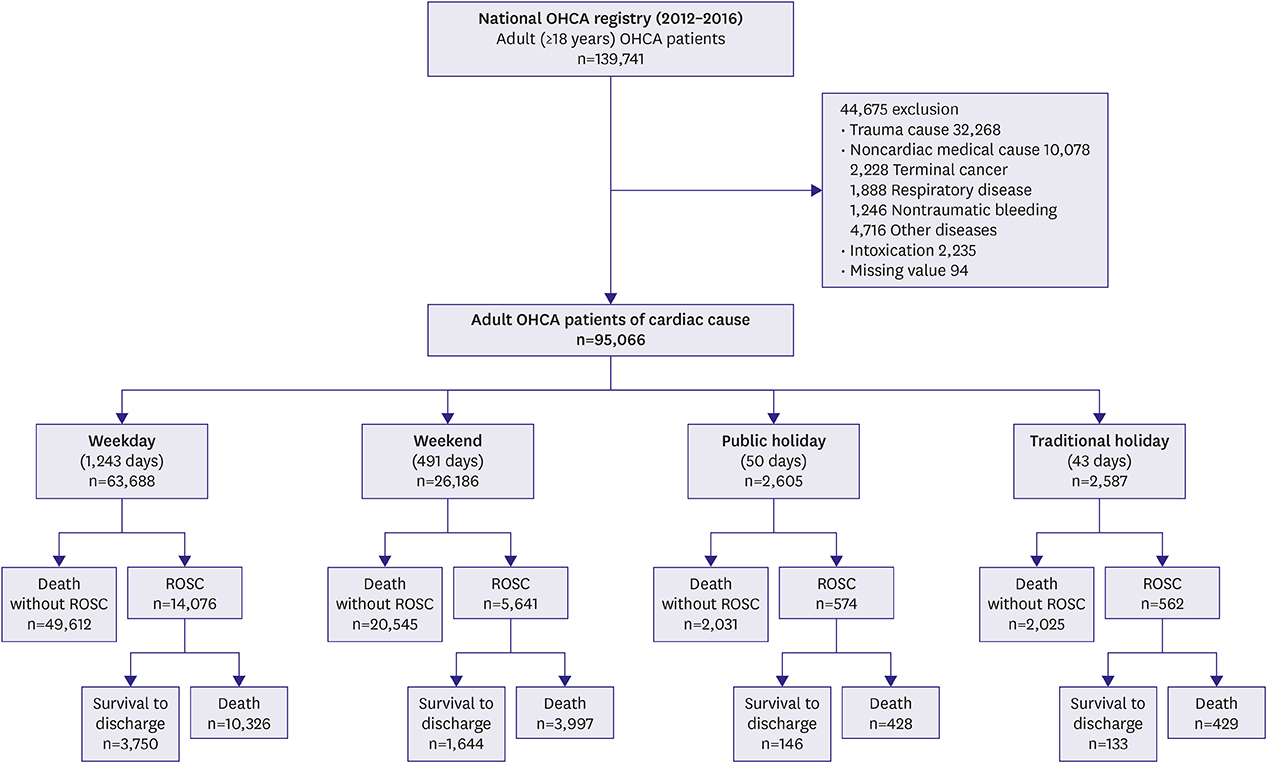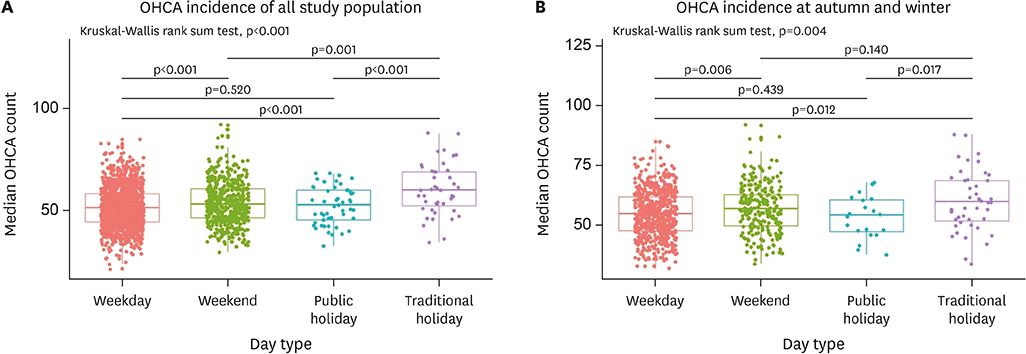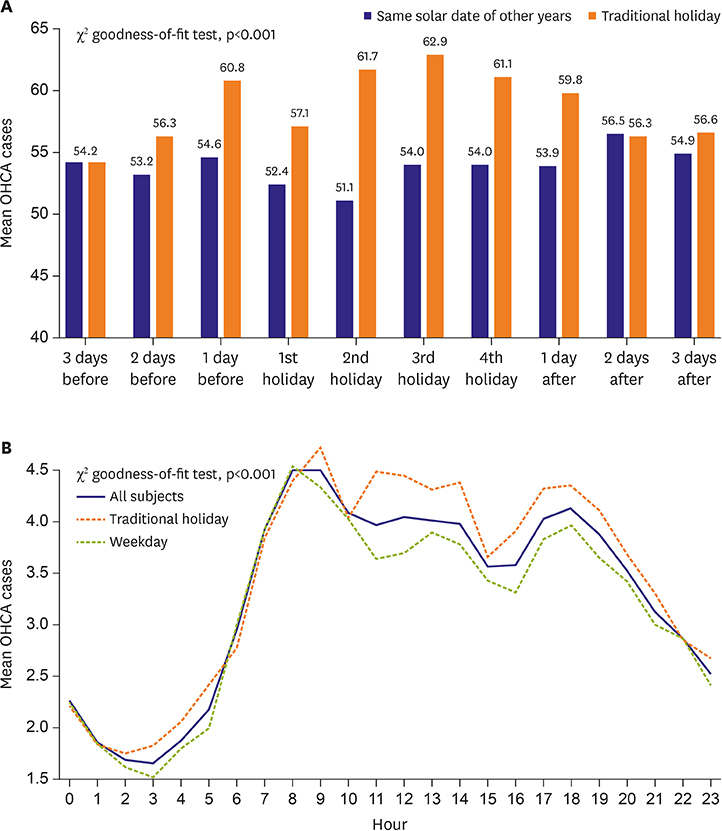Korean Circ J.
2019 Oct;49(10):945-956. 10.4070/kcj.2019.0040.
High Incidence and Mortality of Out-of-Hospital Cardiac Arrest on Traditional Holiday in South Korea
- Affiliations
-
- 1Department of Emergency Medicine, Mediplex Sejong Hospital, Incheon, Korea.
- 2Division of Cardiology, Department of Internal Medicine, Cardiovascular Center, Mediplex Sejong Hospital, Incheon, Korea. imcardio@gmail.com
- KMID: 2458002
- DOI: http://doi.org/10.4070/kcj.2019.0040
Abstract
- BACKGROUND AND OBJECTIVES
This study aimed to confirm the effects of traditional holidays on the incidence and outcomes of out-of-hospital cardiac arrest (OHCA) in South Korea.
METHODS
We studied 95,066 OHCAs of cardiac cause from a nationwide, prospective study from the Korea OHCA Registry from January 2012 to December 2016. We compared the incidence of OHCA, in-hospital mortality, and neurologic outcomes between traditional holidays, Seollal (Lunar New Year's Day) and Chuseok (Korean Thanksgiving Day), and other day types (weekday, weekend, and public holiday).
RESULTS
OHCA occurred more frequently on traditional holidays than on the other days. The median OHCA incidence were 51.0 (interquartile range [IQR], 44.0-58.0), 53.0 (IQR, 46.0-60.5), 52.5 (IQR, 45.3-59.8), and 60.0 (IQR, 52.0-69.0) cases/day on weekday, weekend, public holiday, and traditional holiday, respectively (p<0.001). The OHCA occurred more often at home rather than in public place, lesser bystander cardiopulmonary resuscitation (CPR) was performed, and the rate of cessation of CPR within 20 minutes without recovery of spontaneous circulation was higher on traditional holiday. After multivariable adjustment, traditional holiday was associated with higher in-hospital mortality (adjusted hazard ratio [HR], 1.339; 95% confidence interval [CI], 1.058-1.704; p=0.016) but better neurologic outcomes (adjusted HR, 0.503; 95% CI, 0.281-0.894; p=0.020) than weekdays.
CONCLUSIONS
The incidence of OHCAs was associated with day types in a year. It occurred more frequently on traditional holidays than on other day types. It was associated with higher in-hospital mortality and favorable neurologic outcomes than weekday.
MeSH Terms
Figure
Cited by 1 articles
-
Are Traditional Holidays (Seollal and Chuseok) Harmful for Cardiac Arrest?
Ju-Mi Lee
Korean Circ J. 2019;49(10):957-959. doi: 10.4070/kcj.2019.0159.
Reference
-
1. Gräsner JT, Lefering R, Koster RW, et al. EuReCa ONE-27 Nations, ONE Europe, ONE Registry: a prospective one month analysis of out-of-hospital cardiac arrest outcomes in 27 countries in Europe. Resuscitation. 2016; 105:188–195.2. Benjamin EJ, Virani SS, Callaway CW, et al. Heart disease and stroke statistics-2018 update: a report from the American Heart Association. Circulation. 2018; 137:e67–e492.
Article3. Kim JY, Hwang SO, Shin SD, et al. Korean Cardiac Arrest Research Consortium (KoCARC): rationale, development, and implementation. Clin Exp Emerg Med. 2018; 5:165–176.
Article4. Adrie C, Cariou A, Mourvillier B, et al. Predicting survival with good neurological recovery at hospital admission after successful resuscitation of out-of-hospital cardiac arrest: the OHCA score. Eur Heart J. 2006; 27:2840–2845.
Article5. Bagai A, McNally BF, Al-Khatib SM, et al. Temporal differences in out-of-hospital cardiac arrest incidence and survival. Circulation. 2013; 128:2595–2602.
Article6. Brooks SC, Schmicker RH, Rea TD, et al. Out-of-hospital cardiac arrest frequency and survival: evidence for temporal variability. Resuscitation. 2010; 81:175–181.
Article7. Arntz HR, Willich SN, Schreiber C, Brüggemann T, Stern R, Schultheiss HP. Diurnal, weekly and seasonal variation of sudden death. Population-based analysis of 24,061 consecutive cases. Eur Heart J. 2000; 21:315–320.
Article8. Phillips DP, Jarvinen JR, Abramson IS, Phillips RR. Cardiac mortality is higher around Christmas and New Year's than at any other time: the holidays as a risk factor for death. Circulation. 2004; 110:3781–3788.9. Takahashi K, Shimadzu H. The daily incidence of out-of-hospital cardiac arrest unexpectedly increases around New Year's Day in Japan. Resuscitation. 2015; 96:156–162.
Article10. Mauri R, Burkart R, Benvenuti C, et al. Better management of out-of-hospital cardiac arrest increases survival rate and improves neurological outcome in the Swiss Canton Ticino. Europace. 2016; 18:398–404.
Article11. Sohn K. Suicides around major public holidays in South Korea. Suicide Life Threat Behav. 2017; 47:217–227.
Article12. Nishiyama C, Iwami T, Nichol G, et al. Association of out-of-hospital cardiac arrest with prior activity and ambient temperature. Resuscitation. 2011; 82:1008–1012.
Article13. Batal H, Tench J, McMillan S, Adams J, Mehler PS. Predicting patient visits to an urgent care clinic using calendar variables. Acad Emerg Med. 2001; 8:48–53.
Article14. Kim YT, Shin SD, Hong SO, et al. Effect of national implementation of utstein recommendation from the global resuscitation alliance on ten steps to improve outcomes from Out-of-Hospital cardiac arrest: a ten-year observational study in Korea. BMJ Open. 2017; 7:e016925.
Article15. Holleman DR Jr, Bowling RL, Gathy C. Predicting daily visits to a walk-in clinic and emergency department using calendar and weather data. J Gen Intern Med. 1996; 11:237–239.16. Willich SN. Epidemiologic studies demonstrating increased morning incidence of sudden cardiac death. Am J Cardiol. 1990; 66:15G–17G.
Article17. Savopoulos C, Ziakas A, Hatzitolios A, et al. Circadian rhythm in sudden cardiac death: a retrospective study of 2,665 cases. Angiology. 2006; 57:197–204.
Article
- Full Text Links
- Actions
-
Cited
- CITED
-
- Close
- Share
- Similar articles
-
- Management of Brain Injury after Post-cardiac Arrest Syndrome
- Association between C-reactive protein-to-albumin ratio and 6-month mortality in out-of-hospital cardiac arrest
- Early Experience of Medical Alert System in a Rural Training Hospital: a Pilot Study
- Cardiac arrest during excision of a huge sacrococcygeal teratoma: A report of two cases
- Analysis of perioperative cardiac arrest in a rural hospital in Korea




